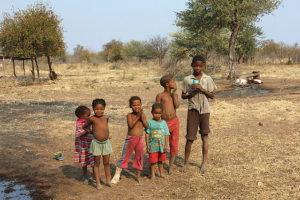A primary school, attended mostly by Ju/’hoansi, serves as the major source of food for many San children who only are able to go when they are fed. The shortcomings of the sporadic school lunch program at the Omatako Primary School near Tsumkwe, the major community of the San in northeastern Namibia, was described in a news story last week.

The news story provides graphic details about the lives of some of the poorer families. For instance, Stephan Riem, a 12-year-old, only goes to school if he can get a meal. He is bullied because he is too poor to afford a school uniform.
His mother, Saara Bobi, is unemployed and relies on plant foods she gathers from the bush to feed her family of six children. She sometimes also receives food supplied by the government. Her kids only go to school when it is providing meals to the children. Currently, none are going.
“No child can concentrate while hungry, so when the school does not provide any meals and we do not get enough food to feed the entire family, then they go into the bush in search of something to eat,” she tells the journalist. The family hovers near the school, however, watching for clues that food is being served to other children so they can go in and have some too.
Muhona Ngurare, the principal of the school, confirms that some children only come when meals are being served. He says that his school has a dropout rate of about 50 percent due to the shortage of foods. He agrees that the lack of attendance is caused by its absence. Despite the failure of the government to provide any food, he remains hopeful. In order to increase attendance, the school developed a strategy of providing food every other week.
The news story last week goes on to report statements and excuses by government officials about what they are doing to correct the widespread poverty among the San people. However, a story in 2012 gives a different impression. A very popular San leader, John Arnold, plus members of his family had been killed in a road accident caused by the poor condition of a highway in the area. The funeral was held in Omatako.
The President of Namibia at the time attended the service along with other dignitaries. In his remarks at the funeral, President Hifikepunye Pohamba told the mourners that the government would devote considerable resources to helping the San people. “We will continue to implement development programmes and projects aimed at empowering members of the San communities,” President Pohamba said. It appears as if there has not been a lot of progress, at least in providing food, over the decade since the former president made those commitments.